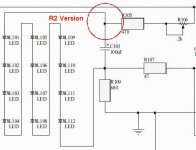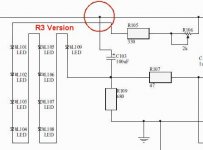Hi,
I currently have the choice of two Phono-Preamp Projects waiting to be soldered over Winter. I would like to base my choice with which to start on the fact which one handles my current favorite Cartridge better.
It's a a "Low-Z" MM Cartridge with 100R recommended loading, 3R DC Resistance, 1mH Inductivity and ultra-low (0,06mv Edit1cm/s) output. The output in fact is so low, that the Trigon Advance in full MC Amplification will not handle it properly.
Will the Paradise be able to work well with such a rare beast?
Any hints welcome
Mike
If you don't mind: what cartridge is that?
I did use lower EL cap values but did not reach a definitive math solution for the relation between it´s values and the 73.5k bass resistor... Maybe someone can give me a hint.
IMO modding EL cap values affects mostly the infrasonic response.
Modifying the bass resistor really affects the riaa curve in the audible range from 20 to 200hz with a peak between 30 and 50hz.
Anyway it is easy to experiment with and I found that we can adjust bass just by slightly mod the bass resistor.
What I really find important is that with the stock values for the riaa:
9100 ohm and 33.3nF that should form the 318us time constant I get a slightly distorted riaa curve as in the pic below.
I do agree that using 9910 ohm and 32.09nF is a much better aproximation. (9910 x 0.03209 = 318)
Ricardo, use the values I reccomended you and you will havea RIAA precision below 0.1dB among the audio band.
As far as the mathematical relationship goes, like I mentioned some time ago, you will have to calculate the transfer function.
As we all know, it affects the very low frequencies, so I would say as long as you have optimum precision down to 20Hz it means that you extend for at least another decade, which is what my simulation shows as well.
You mentioned you tried the lower ELCAP: how did you find it in comparison with the 2X 6.8mF's?
Did you give it a listen to it?
I would be curious to know.
Last question: how did you extract this measurement with? What instruments do you use?
Last edited:
The values I got from simulating helped by my riaa calculator (spreadsheet).
There are variables that I am not totally sure about and that I believe can be different from build to build... Namely first stage output impedance and buffer input impedance.
So it is difficult to predict "exact values", but mine are very near yours.
I always measure the components and do adjustments to reach a "probable" precision.
I mainly use a listening panel to evaluate the results and compare with other builds.
Anyway, based on the reports from other builders that used "stock" riaa and caps values, it sounds very good also so I believe it might be system dependent.
Regarding the EL caps, after discussing the subject with JG, I used lower values because I did not have the indicated values, so I do not have the means to compare... but in my case it works wonderfully.... Paradise bass is outstanding IMO.
I am really glad this turned out to be a very flexible design that responds well to tuning.... We will learn a lot from the numerous builders subjective input to come soon
There are variables that I am not totally sure about and that I believe can be different from build to build... Namely first stage output impedance and buffer input impedance.
So it is difficult to predict "exact values", but mine are very near yours.
I always measure the components and do adjustments to reach a "probable" precision.
I mainly use a listening panel to evaluate the results and compare with other builds.
Anyway, based on the reports from other builders that used "stock" riaa and caps values, it sounds very good also so I believe it might be system dependent.
Regarding the EL caps, after discussing the subject with JG, I used lower values because I did not have the indicated values, so I do not have the means to compare... but in my case it works wonderfully.... Paradise bass is outstanding IMO.
I am really glad this turned out to be a very flexible design that responds well to tuning.... We will learn a lot from the numerous builders subjective input to come soon
Last edited:
I have some autistic tendencies.
What surprises me is that you do not have murderous tendencies!
The values I got from simulating helped by my riaa calculator (spreadsheet).
There are variables that I am not totally sure about and that I believe can be different from build to build... Namely first stage output impedance and buffer input impedance.
So it is difficult to predict "exact values", but mine are very near yours.
I always measure the components and do adjustments to reach a "probable" precision.
I mainly use a listening panel to evaluate the results and compare with other builds.
Anyway, based on the reports from other builders that used "stock" riaa and caps values, it sounds very good also so I believe it might be system dependent.
Regarding the EL caps, after discussing the subject with JG, I used lower values because I did not have the indicated values, so I do not have the means to compare... but in my case it works wonderfully.... Paradise bass is outstanding IMO.
I am really glad this turned out to be a very flexible design that responds well to tuning.... We will learn a lot from the numerous builders subjective input to come soon
so the graph was from simulation.
Anyhow, like I said the bass with a lower elcap won't loose any grip as you are experiencing, but, the mid and high will be much more transparent.
I am glad you like it so far.
Also, the precision I gave along with the values I suggested is actually extracted by bench measurements.
Therefore using the values I quoted will yeald to a very, very tight precision and I am glad because this matches really close simulation.
Yes, design respondes pretty well to tweaking like I anticipated.
The biggest improvement will come from the custom teflon caps for the RIAA but it's too early to talk about this.
enjoy your build and thanks Joachim for this slick design.
Hi. I think there may be an error in the Regulator R3 schematic. See the included schematics. In the R3 version schematic the +Side of C103/C203 is connected to the VPLUS/VMINUS line on top (circled in red). In the previous R1 and R2 version of the schematic, the same capacitor is connected to R105/R205 to act as a filter for the led bank voltage reference. It think this is the correct way of connecting C103/C203 but I may be wrong.
Which schematic is the correct one?
Which schematic is the correct one?

